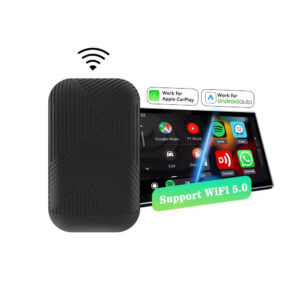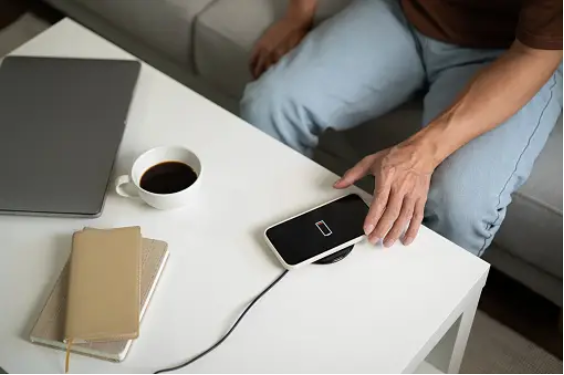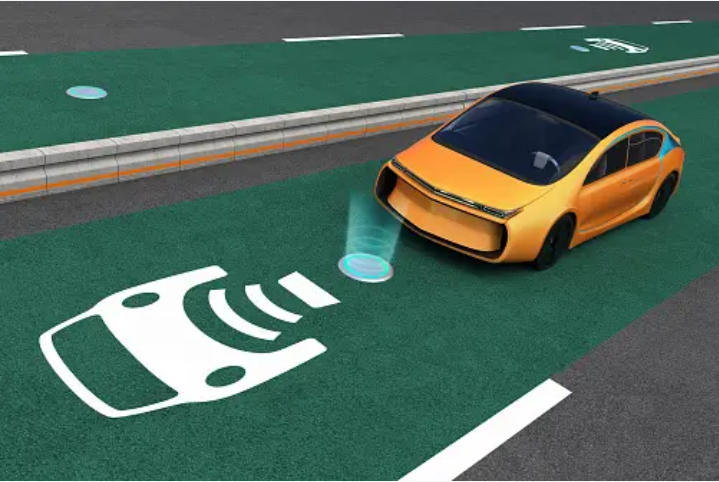Wireless Charging For Your Mobile Phone

What is Wireless Carplay adapter?
Regarding the Wireless CarPlay adapter, let’s first understand CarPlay. What is Carplay? In the center console of a car, there
With the popularity of smartphones, tablets and other electronic devices, the demand for wireless charging market is gradually increasing. According to a report published by market research firm Technavio, the global wireless charger market is expected to reach $14.95 billion by 2025, growing at a CAGR of 13%. This indicates that the wireless charger market has great potential for growth.
Currently, the main manufacturing country for wireless chargers for cell phones is China. China is one of the largest electronics manufacturing countries in the world, and many internationally renowned cell phone brands and electronics manufacturers have factories in China, thus making China one of the major manufacturing countries for wireless chargers for cell phones.
In addition, South Korea and Japan are also one of the major manufacturing countries for wireless chargers for cell phones, as these two countries have world-leading electronics manufacturers, such as Samsung, LG, Sony, etc., which have certain advantages in the development and application of wireless charging technology.
Therefore, the manufacturing countries of wireless chargers for cell phones are mainly in Asian countries such as China, South Korea and Japan, among which China is one of the most important manufacturing countries.

China’s wireless chargers started late, but have developed rapidly with policy and market support. China’s wireless charging technology research and application will also continue to grow and contribute to the development of the global wireless charging market.
In 2011, the Institute of Science and Technology Development Strategy of Qingdao, Shandong University of Science and Technology, Qingdao University of Science and Technology, and Haier Group’s Advanced Technology Research Center in Shandong Province jointly drew and completed the “Wireless Power Transmission Industry Technology Roadmap”, which depicts the resource base, R&D needs, technology barriers, industry needs, and industry goals. It depicts the development path of wireless power transmission industry from resource base, R&D demand, technical barriers, industry demand, industry target and so on.
Meanwhile, some enterprises have made important breakthroughs in wireless charging technology and put it into use through independent or cooperative research and development.
In 2013, the “INPOFI Smart Wireless Charging Technology” developed by Silicon Zhan Technology Company with independent intellectual property rights won the Retailer’s Hot Prize at the U.S. International Consumer Electronics Show, which has the characteristics of no radiation, high efficiency of power conversion, and weak thermal effect, and fills the gaps in wireless charging technology in China.
BYD obtained a patent for a non-contact inductive charger using electromagnetic induction technology. ZTE Corporation cooperated with Dongfeng Motor and officially launched China’s first commercially available wireless charging bus demonstration line in 2014, in which the high-power wireless charging technology uses China’s own intellectual property rights.
ZTE Corporation and Dongfeng Motor officially launched China’s first commercialized wireless charging bus demonstration line in 2014, in which the high-power wireless charging technology uses China’s independent intellectual property rights and takes the lead in realizing the industrialization of wireless charging technology for new energy vehicles.

Apple phones introduced support for wireless charging with the iPhone 8, iPhone 8 Plus and iPhone X in 2017. These phones use the Qi wireless charging standard, which allows them to be charged by placing them on a Qi charging-enabled wireless charger, eliminating the need for a charging cable to connect the phone to the charger. Since then, Apple’s successors such as the iPhone XS, iPhone XS Max, iPhone XR, iPhone 11, iPhone 11 Pro and iPhone 11 Pro Max have also supported wireless charging.
The support of wireless charging in Apple’s cell phones in 2017 had a positive impact on wireless charger industry sales. According to market research firm IDC, the global wireless charger market reached USD 1.61 billion in 2018, representing a year-on-year growth of approximately 123%. Among them, the launch of iPhone is considered to be one of the key factors for the growth of the global wireless charger market.
In 2018, Chinese domestic manufacturers Xiaomi and Huawei started launching wireless charging-enabled cell phone products. Since then, other domestic cell phone brands such as OPPO and vivo have also launched wireless charging cell phone products, driving the popularization of wireless charging technology in China.
Specifically, the demand for wireless chargers by users increased significantly after Apple’s cell phones supported wireless charging, thereby driving the expansion and growth of the wireless charger market. The launch of Apple’s wireless charger AirPower in 2017 reportedly gained much attention in the market, which prompted other manufacturers to launch more wireless charger products to meet the market demand.
Moreover, Apple’s support has led to the adoption and promotion of wireless charging technology. Apple’s entry has led to wider adoption of the Qi wireless charging standard, and many other electronics manufacturers have begun to join the wireless charger market. For example, Samsung, LG, Huawei and other cell phone brands have also launched products that support wireless charging.
At the policy level, the Chinese government has also strengthened its support for wireless charging technology.In 2015, China released the guidelines for the National Science and Technology Major Special Project “New Generation Broadband Wireless Mobile Communication Network” (“863” Program), which clarified the importance and development direction of wireless charging In 2016, the National Development and Reform Commission (NDRC), the Ministry of Science and Technology (MOST), the Ministry of Industry and Information Technology (MIIT), and the Ministry of Finance (MOF) jointly issued the “13th Five-Year Plan for Industrial Technology Innovation”, which listed wireless charging as one of the key areas.
At present, China’s wireless charging technology has made some progress, and domestic companies have invested a lot of resources in the development and production of wireless chargers. For example, Xiaomi has launched a wireless charger that supports 30W fast charging, Huawei has launched a wireless charger that supports 40W fast charging, and OPPO has launched a wireless charger that supports 30W fast charging. In addition, some companies are also exploring the application of wireless charging technology in the field of electric vehicles, such as BYD and SAIC.

IT companies occupy a dominant position in the wireless charging market because they can focus their advantageous resources on promoting the development and application of wireless charging technology. For example, Microsoft released the DT-903 wireless charging pad, and Google released a wireless charging pad and Nexus 5 case. These new products are more compatible with smart devices and provide consumers with a better experience.
Cell phone manufacturing companies are also major players in the wireless charging market, such as Samsung, Apple, and others. These companies have started to widely apply wireless charging technology in their flagship products, such as Samsung Galaxy S21, Apple iPhone 12, and others. The launch of these products has promoted the popularization of the application of wireless charging technology and accelerated the development of the market.

Semiconductor companies are also among the players in the wireless charging market. For example, Texas Instruments Incorporated and Freescale Freescale have started to provide chips and control technology for wireless charging technology. The participation of these companies can accelerate the application promotion of wireless charging technology and improve the competitiveness of the market.
At present, the competitive landscape of the global wireless charging market is relatively decentralized. Although some companies have achieved certain results in the research and development and application of wireless charging technology, the market share is fragmented and no monopoly situation has emerged. However, with the continuous expansion of the market, the competition will become more and more intense. Therefore, companies need to strengthen their technology R&D and market promotion in order to increase their market share.Currently, the wireless charger market has a complex competitive landscape, with major competitors coming from multiple players such as electronics manufacturers, wireless charging solution providers, and charger producers.
In terms of electronics manufacturers, cell phone brands such as Apple, Samsung, and Huawei are the major drivers and competitors in the wireless charger market. The smartphones launched by these manufacturers support wireless charging features and are also constantly upgrading and improving the wireless charging technology to increase the charging speed and efficiency.
In terms of wireless charging solution providers, there are some companies that specialize in providing wireless charging technology solutions, such as Energous from the United States, Würth Elektronik from Germany, and Powermat from Israel. These companies provide wireless charging modules, chips, software and other solutions, providing technical support and cooperation opportunities for cell phone manufacturers and charger manufacturers.
When it comes to charger manufacturers, there are many companies that specialize in wireless chargers, such as Ambridge Technology, RAVPower, Anker, and others. These companies have introduced wireless charger products with different features and prices, covering everything from regular entry-level chargers to high-end fast chargers.
The wireless charger market has also attracted the attention of some of the major tech companies such as Google, Microsoft, and Intel, which are also accelerating the research and adoption of wireless charging technology.
The competitive landscape of the wireless charger market is again complex, with major competitors coming from multiple players such as electronics manufacturers, wireless charging solution providers, and charger producers. In the future, as wireless charging technology continues to advance and become more popular, the competition in the wireless charger market is expected to become more intense.

Regarding the Wireless CarPlay adapter, let’s first understand CarPlay. What is Carplay? In the center console of a car, there
1-1-300x152.jpg)
Dear partners and customers, We sincerely invite you to participate in the 2024 Spring Hong Kong Electronics Exhibition. As a

magnetic car holders in themselves do not disrupt wireless charging, unless the specific design places the magnet too close to
Phone: 0086-755-89812186
Email: sales@inputcn.com
Address: 518129 2F Building 1, Baoli Industrial Zone,
Bantian, Longgang District, Shenzhen, China.

